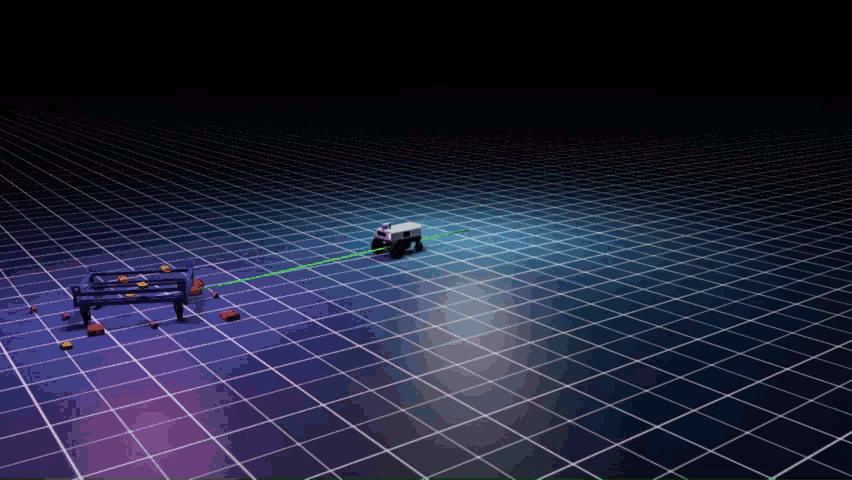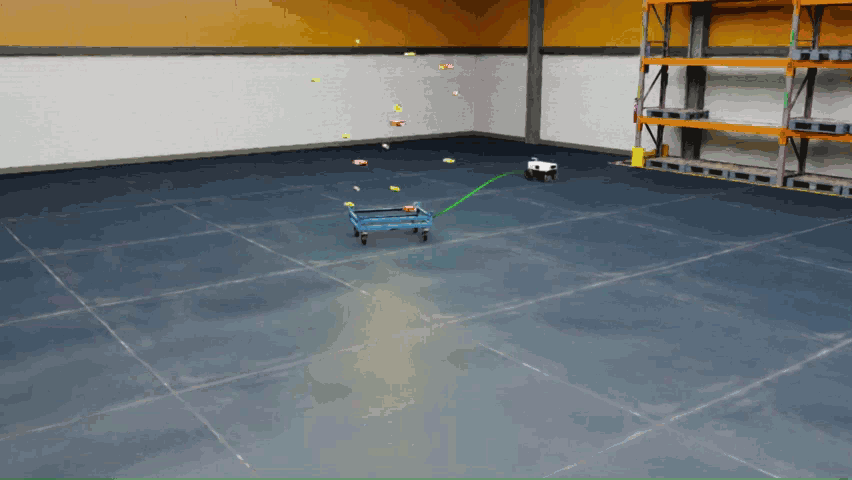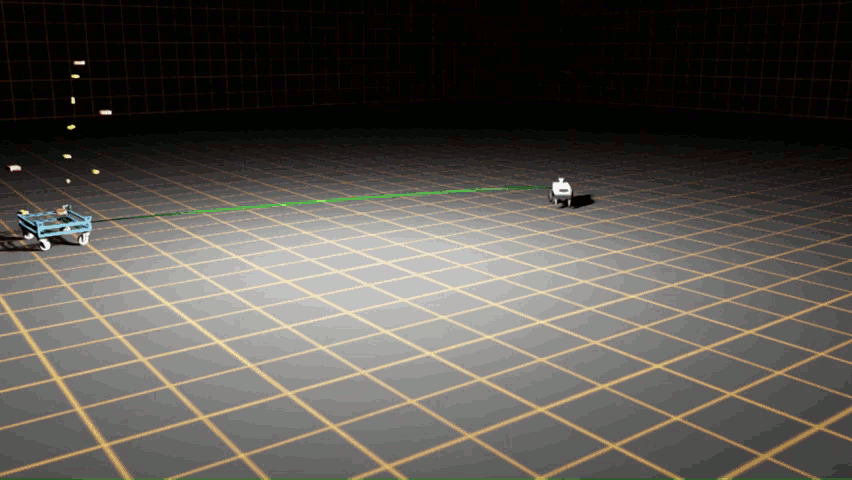Randomization in Simulation – AMR Navigation#
Example of using Isaac Sim and Replicator to capture synthetic data from simulated environments (AMR Navigation).
Learning Objectives#
The goal of this tutorial is to demonstrate how to setup an Isaac Sim simulation scenario together with the omni.replicator extension to capture synthetic data using diverse randomization techniques.
In this tutorial you:
Implement scene randomizations using USD / Isaac Sim APIs:
Randomize poses of assets in the scene
Switch between different background environments
Collect synthetic data at specific simulation events with Replicator
Create and destroy render products on the fly to improve runtime performance
Create and destroy Replicator capture graphs within the same simulation instance
Prerequisites#
Familiarity with USD / Isaac Sim APIs for scene creation and manipulation.
Familiarity with omni.replicator and its writers.
Basic understanding of OmniGraph for the navigation implementation.
Running simulations as Standalone Applications or via the Script Editor.
Scenario#
This tutorial uses the Nova Carter robot equipped with an OmniGraph navigation stack, notably without collision avoidance features. The navigation stack constantly drives the robot towards a designated Xform target (<..>/targetXform), positioned at the location of the randomized objects of interest. As the robot comes in the proximity of the object of interest, a synthetic data generation (SDG) pipeline is triggered to capture data from its two main camera sensors. After the data is captured the objects of interest are re-randomized and the simulation continues. After a certain number of frames (env_interval) the background environment is changed as well. After num_frames the application terminates.
The use_temp_rp flag is used to provide an option to use temporary render products to improve the runtime performance. This speeds up the simulation by only using the render products when capturing the data, thus avoiding the overhead of rendering the sensor views when not capturing data.



The scenario uses the left and right camera sensors of Nova Carter (<..>/stereo_cam_<left/right>_sensor_frame/camera_sensor_<left/right>) to collect LdrColor (rgb) annotator data using Replicator. By default, the data is written to <working_dir>/_out_nav_sdg_demo and runs for num_frames=9 iterations.
Furthermore, it changes the background environment every env_interval=3 captured frames. The use_temp_rp flag can be used to optimize performance by disabling the sensor render products during simulation and temporarily enabling them during data capture.
The following image provides an illustration of the resulting data from the various environments.

Implementation#
The following section provides an overview and explanation of the implementation and examples on how to run the demo.
To run the example as a standalone application, use the following command to execute the provided script. The script also accepts several optional arguments to customize its behavior:
./python.sh standalone_examples/replicator/amr_navigation.py
Arguments include:
--use_temp_rpflag to use temporary render products (default: False)--num_framesthe number of frames to be captured (default: 9)--env_intervalthe capture interval at which the background environment is changed (default: 3)
For example, to run the application with all the arguments:
./python.sh standalone_examples/replicator/amr_navigation.py --use_temp_rp --num_frames 9 --env_interval 3
This tab describes each section of the larger sample script that is used for this tutorial. By reviewing the descriptions and code snippets you can understand how the script is working and how you might customize it for your use.
The following snippets can be used to load and start the demo scene. Each of the snippets has an explanation that can be expanded. The snippets and explanations are collapsed so that you can control opening them as you read and work through the tutorial for yourself.
Running the AMR Navigation SDG Demo
The following snippet is from the end of the code sample, it runs for the given num_frames and changes the background environment every env_interval. The output is written to the given out_dir path. The use_temp_rp parameter can be used to optimize performance by creating render products only for the frames when the data is captured.
The start method loads and runs the demo with the specified parameters, while clear halts the demo and clears any active subscribers and render products. You can use is_running to verify whether the demo is still running.
Running the NavSDGDemo Python Script Example
ENV_INTERVAL = 3
NUM_FRAMES = 9
USE_TEMP_RP = True
nav_demo = NavSDGDemo()
nav_demo.start(
num_frames=NUM_FRAMES,
out_dir=out_dir,
env_urls=ENV_URLS,
env_interval=ENV_INTERVAL,
use_temp_rp=USE_TEMP_RP,
seed=22,
)
NavSDGDemo Class and Attributes
The demo script is wrapped in its own class called NavSDGDemo.
NavSDGDemo Class Snippet
class NavSDGDemo:
CARTER_URL = "/Isaac/Samples/Replicator/OmniGraph/nova_carter_nav_only.usd"
DOLLY_URL = "/Isaac/Props/Dolly/dolly_physics.usd"
PROPS_URL = "/Isaac/Props/YCB/Axis_Aligned_Physics"
LEFT_CAMERA_PATH = "/NavWorld/CarterNav/chassis_link/front_hawk/left/camera_left"
RIGHT_CAMERA_PATH = "/NavWorld/CarterNav/chassis_link/front_hawk/right/camera_right"
def __init__(self):
self._carter_chassis = None
self._carter_nav_target = None
self._dolly = None
self._dolly_light = None
self._props = []
self._cycled_env_urls = None
self._env_interval = 1
self._timeline = None
self._timeline_sub = None
self._stage_event_sub = None
self._stage = None
self._trigger_distance = 2.0
self._num_frames = 0
self._frame_counter = 0
self._writer = None
self._out_dir = None
self._render_products = []
self._use_temp_rp = False
self._in_running_state = False
The attributes of this class include:
self._carter_chassisandself._carter_nav_targetprims are used to track Nova Carter and its target Xform in the navigation graphself._dollyis used as the target for the navigation target of Nova Carter and to track the distance to Nova Carterself._dolly_lightrandomized light placed above the dolly each captured frameself._propslist of prop prims to place and simulate above the dolly each captured frameself._cycled_env_urlsthe paths for the background environments to cycle throughself._env_intervalis used to determine after how many frames to change the background environmentself._timelineis used to control (play/pause) the simulation timeline between frame capturesself._timeline_subis the subscriber to the timeline ticks. It is used as the feedback loop to trigger the synthetic data generationself._stage_event_subis a subscriber to stage closing events used to clear the demo in case a new stage is openedself._stageis used to access the active stage in order to create, access, and delete prims of interestself._trigger_distanceis used to determine the distance between Nova Carter and the dolly at which the synthetic data generation should trigger, the value is randomized after each captureself._num_framesandself._frame_counterare used to track and stop the demo after the given number of frames.self._writeris the writer used to write the synthetic data to diskself._render_productsare the two render products attached to the left and right camera sensors of Nova Carter, the writer is attached to these to access data from the annotatorsself._use_temp_rpis a flag, which when set toTrue, causes the demo to create and destroy render products for each frame capture. Otherwise the render products are created once at the start of the demo and destroyed at the endself._in_running_stateindicates the running state of the demo used to track whether the demo has finished or not
Workflow and Start Function
The workflow’s main functions are start and the _on_timeline_event callback functions. start creates a new environment with:
navigation specific physics scene
Nova Carter
navigation graph with the target Xform
dolly
randomization light
props to drop around the dolly
It also creates the timeline subscriber with _on_timeline_event as the callback function triggered with each timeline tick. The _on_timeline_event function checks if Nova Carter is close enough to the dolly, if so it pauses the simulation, unsubscribes the timeline callback, and triggers the synthetic data generation (SDG). Depending on whether the demo is running in the script editor or as a standalone application it runs the SDG synchronously or asynchronously.
Workflow Snippet
def start(..)
[..]
self._load_env()
self._randomize_dolly_pose()
self._randomize_dolly_light()
self._randomize_prop_poses()
self._setup_sdg()
[..]
self._timeline_sub = self._timeline.get_timeline_event_stream().create_subscription_to_pop_by_type(
int(omni.timeline.TimelineEventType.CURRENT_TIME_TICKED), self._on_timeline_event
)
[..]
def _on_timeline_event(self, e: carb.events.IEvent):
carter_loc = self._carter_chassis.GetAttribute("xformOp:translate").Get()
dolly_loc = self._dolly.GetAttribute("xformOp:translate").Get()
dist = (Gf.Vec2f(dolly_loc[0], dolly_loc[1]) - Gf.Vec2f(carter_loc[0], carter_loc[1])).GetLength()
if dist < self._trigger_distance:
print(f"[NavSDGDemo] Starting SDG for frame no. {self._frame_counter}")
self._timeline.pause()
self._timeline_sub.unsubscribe()
if self._is_running_in_script_editor():
import asyncio
task = asyncio.ensure_future(self._run_sdg_async())
task.add_done_callback(self._on_sdg_done)
else:
self._run_sdg()
self._setup_next_frame()
Randomizations Explanation
To randomize the environment before the synthetic data capture, the following functions are used:
_randomize_dolly_pose: places the dolly at a random pose with a given minimum distance from Nova Carter. After such a pose is found, the navigation target is placed at the dolly’s position._randomize_dolly_light: places the dolly light above the dolly with a new random color._randomize_prop_poses: places the props above the dolly at random locations, which eventually starts to fall after the simulation starts.
Randomizations Snippet
def _randomize_dolly_pose(self):
min_dist_from_carter = 4
carter_loc = self._carter_chassis.GetAttribute("xformOp:translate").Get()
for _ in range(100):
x, y = random.uniform(-6, 6), random.uniform(-6, 6)
dist = (Gf.Vec2f(x, y) - Gf.Vec2f(carter_loc[0], carter_loc[1])).GetLength()
if dist > min_dist_from_carter:
self._dolly.GetAttribute("xformOp:translate").Set((x, y, 0))
self._carter_nav_target.GetAttribute("xformOp:translate").Set((x, y, 0))
break
self._dolly.GetAttribute("xformOp:rotateXYZ").Set((0, 0, random.uniform(-180, 180)))
def _randomize_dolly_light(self):
dolly_loc = self._dolly.GetAttribute("xformOp:translate").Get()
self._dolly_light.GetAttribute("xformOp:translate").Set(dolly_loc + (0, 0, 2.5))
self._dolly_light.GetAttribute("inputs:color").Set(
(random.uniform(0, 1), random.uniform(0, 1), random.uniform(0, 1))
)
def _randomize_prop_poses(self):
spawn_loc = self._dolly.GetAttribute("xformOp:translate").Get()
spawn_loc[2] = spawn_loc[2] + 0.5
for prop in self._props:
prop.GetAttribute("xformOp:translate").Set(spawn_loc + (random.uniform(-1, 1), random.uniform(-1, 1), 0))
spawn_loc[2] = spawn_loc[2] + 0.2
Synthetic Data Generation (SDG) Explanation
When executing the synthetic data generation (SDG) pipeline the rep.orchestrator.step function is called to initiate the data capture and the execution of the writer’s write function. The rep.orchestrator.wait_until_complete function makes sure the writer is finished with writing the data to disk.
Depending on the value of the use_temp_rp flag, the sensor’s render products are handled differently:
If set to
True, the render products are only enabled during data capture.Falseis the default. It renders the render products and processes every frame.
Synthetic Data Generation (SDG) Snippet
def _run_sdg(self):
if self._use_temp_rp:
self._enable_render_products()
rep.orchestrator.step(rt_subframes=16, delta_time=0.0)
rep.orchestrator.wait_until_complete()
if self._use_temp_rp:
self._disable_render_products()
Next Frame Explanation
After the synthetic data generation (SDG) completes, the _setup_next_frame function prepares the simulation for the next frame. This involves incrementing the frame counter (self._frame_counter), randomizing the dolly, dolly light, and props. Then changing the background environment, if the env_interval is reached. Additionally the timeline and its subscriber are re-started.
If the _num_frames is reached the demo terminates.
Next Frame Snippet
def _setup_next_frame(self):
self._frame_counter += 1
if self._frame_counter >= self._num_frames:
print(f"[NavSDGDemo] Finished")
self.clear()
return
self._randomize_dolly_pose()
self._randomize_dolly_light()
self._randomize_prop_poses()
if self._frame_counter % self._env_interval == 0:
self._load_next_env()
# Set a new random distance from which to take capture the next frame
self._trigger_distance = random.uniform(1.75, 2.5)
self._timeline.play()
self._timeline_sub = self._timeline.get_timeline_event_stream().create_subscription_to_pop_by_type(
int(omni.timeline.TimelineEventType.CURRENT_TIME_TICKED), self._on_timeline_event
)
To run the example from the script editor, the following code must be executed:
import builtins
import os
import random
from itertools import cycle
import carb.settings
import omni.client
import omni.kit.app
import omni.replicator.core as rep
import omni.timeline
import omni.usd
from omni.isaac.nucleus import get_assets_root_path
from omni.isaac.core.utils.stage import add_reference_to_stage, create_new_stage
from pxr import Gf, PhysxSchema, UsdGeom, UsdLux, UsdPhysics
class NavSDGDemo:
CARTER_URL = "/Isaac/Samples/Replicator/OmniGraph/nova_carter_nav_only.usd"
DOLLY_URL = "/Isaac/Props/Dolly/dolly_physics.usd"
PROPS_URL = "/Isaac/Props/YCB/Axis_Aligned_Physics"
LEFT_CAMERA_PATH = "/NavWorld/CarterNav/chassis_link/front_hawk/left/camera_left"
RIGHT_CAMERA_PATH = "/NavWorld/CarterNav/chassis_link/front_hawk/right/camera_right"
def __init__(self):
self._carter_chassis = None
self._carter_nav_target = None
self._dolly = None
self._dolly_light = None
self._props = []
self._cycled_env_urls = None
self._env_interval = 1
self._timeline = None
self._timeline_sub = None
self._stage_event_sub = None
self._stage = None
self._trigger_distance = 2.0
self._num_frames = 0
self._frame_counter = 0
self._writer = None
self._out_dir = None
self._render_products = []
self._use_temp_rp = False
self._in_running_state = False
def start(
self,
num_frames=10,
out_dir=None,
env_urls=[],
env_interval=3,
use_temp_rp=False,
seed=None,
):
print(f"[NavSDGDemo] Starting")
if seed is not None:
random.seed(seed)
self._num_frames = num_frames
self._out_dir = out_dir if out_dir is not None else os.path.join(os.getcwd(), "_out_nav_sdg_demo")
self._cycled_env_urls = cycle(env_urls)
self._env_interval = env_interval
self._use_temp_rp = use_temp_rp
self._frame_counter = 0
self._trigger_distance = 2.0
self._load_env()
self._randomize_dolly_pose()
self._randomize_dolly_light()
self._randomize_prop_poses()
self._setup_sdg()
self._timeline = omni.timeline.get_timeline_interface()
self._timeline.play()
self._timeline_sub = self._timeline.get_timeline_event_stream().create_subscription_to_pop_by_type(
int(omni.timeline.TimelineEventType.CURRENT_TIME_TICKED), self._on_timeline_event
)
self._stage_event_sub = (
omni.usd.get_context()
.get_stage_event_stream()
.create_subscription_to_pop_by_type(int(omni.usd.StageEventType.CLOSING), self._on_stage_closing_event)
)
self._in_running_state = True
def clear(self):
self._cycled_env_urls = None
self._carter_chassis = None
self._carter_nav_target = None
self._dolly = None
self._dolly_light = None
self._timeline = None
self._frame_counter = 0
if self._stage_event_sub:
self._stage_event_sub.unsubscribe()
self._stage_event_sub = None
if self._timeline_sub:
self._timeline_sub.unsubscribe()
self._timeline_sub = None
self._clear_sdg_render_products()
self._stage = None
self._in_running_state = False
def is_running(self):
return self._in_running_state
def _is_running_in_script_editor(self):
return builtins.ISAAC_LAUNCHED_FROM_TERMINAL is True
def _on_stage_closing_event(self, e: carb.events.IEvent):
self.clear()
def _load_env(self):
# Fresh stage with custom physics scene for Nova Carter's navigation
create_new_stage()
self._stage = omni.usd.get_context().get_stage()
self._add_physics_scene()
# Environment
assets_root_path = get_assets_root_path()
add_reference_to_stage(usd_path=assets_root_path + next(self._cycled_env_urls), prim_path="/Environment")
# Nova Carter
add_reference_to_stage(usd_path=assets_root_path + self.CARTER_URL, prim_path="/NavWorld/CarterNav")
self._carter_nav_target = self._stage.GetPrimAtPath("/NavWorld/CarterNav/targetXform")
self._carter_chassis = self._stage.GetPrimAtPath("/NavWorld/CarterNav/chassis_link")
# Dolly
add_reference_to_stage(usd_path=assets_root_path + self.DOLLY_URL, prim_path="/NavWorld/Dolly")
self._dolly = self._stage.GetPrimAtPath("/NavWorld/Dolly")
if not self._dolly.GetAttribute("xformOp:translate"):
UsdGeom.Xformable(self._dolly).AddTranslateOp()
if not self._dolly.GetAttribute("xformOp:rotateXYZ"):
UsdGeom.Xformable(self._dolly).AddRotateXYZOp()
# Light
light = UsdLux.SphereLight.Define(self._stage, f"/NavWorld/DollyLight")
light.CreateRadiusAttr(0.5)
light.CreateIntensityAttr(35000)
light.CreateColorAttr(Gf.Vec3f(1.0, 1.0, 1.0))
self._dolly_light = light.GetPrim()
if not self._dolly_light.GetAttribute("xformOp:translate"):
UsdGeom.Xformable(self._dolly_light).AddTranslateOp()
# Props
props_urls = []
props_folder_path = assets_root_path + self.PROPS_URL
result, entries = omni.client.list(props_folder_path)
if result != omni.client.Result.OK:
carb.log_error(f"Could not list assets in path: {props_folder_path}")
return
for entry in entries:
_, ext = os.path.splitext(entry.relative_path)
if ext == ".usd":
props_urls.append(f"{props_folder_path}/{entry.relative_path}")
cycled_props_url = cycle(props_urls)
for i in range(15):
prop_url = next(cycled_props_url)
prop_name = os.path.splitext(os.path.basename(prop_url))[0]
path = f"/NavWorld/Props/Prop_{prop_name}_{i}"
prim = self._stage.DefinePrim(path, "Xform")
prim.GetReferences().AddReference(prop_url)
self._props.append(prim)
def _add_physics_scene(self):
# Physics setup specific for the navigation graph
physics_scene = UsdPhysics.Scene.Define(self._stage, "/physicsScene")
physx_scene = PhysxSchema.PhysxSceneAPI.Apply(self._stage.GetPrimAtPath("/physicsScene"))
physx_scene.GetEnableCCDAttr().Set(True)
physx_scene.GetEnableGPUDynamicsAttr().Set(False)
physx_scene.GetBroadphaseTypeAttr().Set("MBP")
def _randomize_dolly_pose(self):
min_dist_from_carter = 4
carter_loc = self._carter_chassis.GetAttribute("xformOp:translate").Get()
for _ in range(100):
x, y = random.uniform(-6, 6), random.uniform(-6, 6)
dist = (Gf.Vec2f(x, y) - Gf.Vec2f(carter_loc[0], carter_loc[1])).GetLength()
if dist > min_dist_from_carter:
self._dolly.GetAttribute("xformOp:translate").Set((x, y, 0))
self._carter_nav_target.GetAttribute("xformOp:translate").Set((x, y, 0))
break
self._dolly.GetAttribute("xformOp:rotateXYZ").Set((0, 0, random.uniform(-180, 180)))
def _randomize_dolly_light(self):
dolly_loc = self._dolly.GetAttribute("xformOp:translate").Get()
self._dolly_light.GetAttribute("xformOp:translate").Set(dolly_loc + (0, 0, 2.5))
self._dolly_light.GetAttribute("inputs:color").Set(
(random.uniform(0, 1), random.uniform(0, 1), random.uniform(0, 1))
)
def _randomize_prop_poses(self):
spawn_loc = self._dolly.GetAttribute("xformOp:translate").Get()
spawn_loc[2] = spawn_loc[2] + 0.5
for prop in self._props:
prop.GetAttribute("xformOp:translate").Set(spawn_loc + (random.uniform(-1, 1), random.uniform(-1, 1), 0))
spawn_loc[2] = spawn_loc[2] + 0.2
def _setup_sdg(self):
# Disable capture on play and async rendering
carb.settings.get_settings().set("/omni/replicator/captureOnPlay", False)
carb.settings.get_settings().set("/omni/replicator/asyncRendering", False)
carb.settings.get_settings().set("/app/asyncRendering", False)
# Set camera sensors fStop to 0.0 to get well lit sharp images
left_camera_prim = self._stage.GetPrimAtPath(self.LEFT_CAMERA_PATH)
left_camera_prim.GetAttribute("fStop").Set(0.0)
right_camera_prim = self._stage.GetPrimAtPath(self.RIGHT_CAMERA_PATH)
right_camera_prim.GetAttribute("fStop").Set(0.0)
self._writer = rep.WriterRegistry.get("BasicWriter")
self._writer.initialize(output_dir=self._out_dir, rgb=True)
self._setup_sdg_render_products()
def _setup_sdg_render_products(self):
print(f"[NavSDGDemo] Creating SDG render products")
rp_left = rep.create.render_product(
self.LEFT_CAMERA_PATH,
(1024, 1024),
name="left_sensor",
force_new=True,
)
rp_right = rep.create.render_product(
self.RIGHT_CAMERA_PATH,
(1024, 1024),
name="right_sensor",
force_new=True,
)
self._render_products = [rp_left, rp_right]
# For better performance the render products can be disabled when not in use, and re-enabled only during SDG
if self._use_temp_rp:
self._disable_render_products()
self._writer.attach(self._render_products)
rep.orchestrator.preview()
def _clear_sdg_render_products(self):
print(f"[NavSDGDemo] Clearing SDG render products")
if self._writer:
self._writer.detach()
for rp in self._render_products:
rp.destroy()
self._render_products.clear()
if self._stage.GetPrimAtPath("/Replicator"):
omni.kit.commands.execute("DeletePrimsCommand", paths=["/Replicator"])
def _enable_render_products(self):
print(f"[NavSDGDemo] Enabling render products for SDG..")
for rp in self._render_products:
rp.hydra_texture.set_updates_enabled(True)
def _disable_render_products(self):
print(f"[NavSDGDemo] Disabling render products (enabled only during SDG)..")
for rp in self._render_products:
rp.hydra_texture.set_updates_enabled(False)
def _run_sdg(self):
if self._use_temp_rp:
self._enable_render_products()
rep.orchestrator.step(rt_subframes=16, delta_time=0.0)
rep.orchestrator.wait_until_complete()
if self._use_temp_rp:
self._disable_render_products()
async def _run_sdg_async(self):
if self._use_temp_rp:
self._enable_render_products()
await rep.orchestrator.step_async(rt_subframes=16, delta_time=0.0)
await rep.orchestrator.wait_until_complete_async()
if self._use_temp_rp:
self._disable_render_products()
def _load_next_env(self):
if self._stage.GetPrimAtPath("/Environment"):
omni.kit.commands.execute("DeletePrimsCommand", paths=["/Environment"])
assets_root_path = get_assets_root_path()
add_reference_to_stage(usd_path=assets_root_path + next(self._cycled_env_urls), prim_path="/Environment")
def _on_sdg_done(self, task):
self._setup_next_frame()
def _setup_next_frame(self):
self._frame_counter += 1
if self._frame_counter >= self._num_frames:
print(f"[NavSDGDemo] Finished")
self.clear()
return
self._randomize_dolly_pose()
self._randomize_dolly_light()
self._randomize_prop_poses()
if self._frame_counter % self._env_interval == 0:
self._load_next_env()
# Set a new random distance from which to take capture the next frame
self._trigger_distance = random.uniform(1.75, 2.5)
self._timeline.play()
self._timeline_sub = self._timeline.get_timeline_event_stream().create_subscription_to_pop_by_type(
int(omni.timeline.TimelineEventType.CURRENT_TIME_TICKED), self._on_timeline_event
)
def _on_timeline_event(self, e: carb.events.IEvent):
carter_loc = self._carter_chassis.GetAttribute("xformOp:translate").Get()
dolly_loc = self._dolly.GetAttribute("xformOp:translate").Get()
dist = (Gf.Vec2f(dolly_loc[0], dolly_loc[1]) - Gf.Vec2f(carter_loc[0], carter_loc[1])).GetLength()
if dist < self._trigger_distance:
print(f"[NavSDGDemo] Starting SDG for frame no. {self._frame_counter}")
self._timeline.pause()
self._timeline_sub.unsubscribe()
if self._is_running_in_script_editor():
import asyncio
task = asyncio.ensure_future(self._run_sdg_async())
task.add_done_callback(self._on_sdg_done)
else:
self._run_sdg()
self._setup_next_frame()
ENV_URLS = [
"/Isaac/Environments/Grid/default_environment.usd",
"/Isaac/Environments/Simple_Warehouse/warehouse.usd",
"/Isaac/Environments/Grid/gridroom_black.usd",
]
ENV_INTERVAL = 3
NUM_FRAMES = 9
USE_TEMP_RP = True
out_dir = os.path.join(os.getcwd(), "_out_nav_sdg_demo", "")
nav_demo = NavSDGDemo()
nav_demo.start(
num_frames=NUM_FRAMES,
out_dir=out_dir,
env_urls=ENV_URLS,
env_interval=ENV_INTERVAL,
use_temp_rp=USE_TEMP_RP,
seed=22,
)